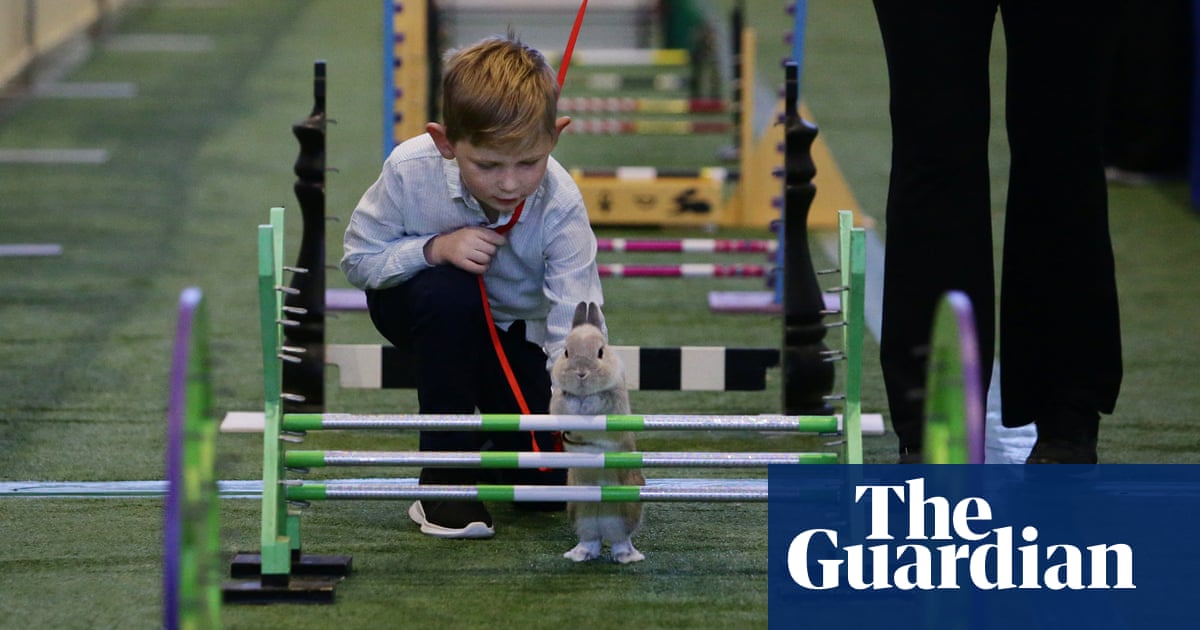On a crisp Sunday morning, the Pet Pavilion at Sydney’s Royal Easter Show smells of donuts and hay.
A crowd mills around a fenced-off patch of astroturf, where colourful jumps set to different heights are arranged in a long row.
They are here to see 26 competitors take part in kaninhop, also known as rabbit showjumping. As the name suggests, kaninhop has its origins in Sweden, but it has spread globally since the 1970s.
Natasha McGarry is a senior judge at the show, and also president of the Rabbit Hopping Society of Australia.
The four-time national Rabbit Hopper of the Year, who lives with 25 house-trained rabbits, fell in love with the sport as a teenager in 2013 and has been competing in the greater Sydney area ever since.
There are fourevents: straight course, crooked course, high jump and long jump.
McGarry explains the straight course rules to the curious crowd: the winner is the rabbit that collects the “least rail knocks, followed by quickest time”. (There are more caveats in the 48-page Australianrule book.)
Everyone holds their breath as a girl wearing long purple braids approaches.
Her black-and-white Harlequin rabbit, Batman, wears the competition standard H-shaped harness with a D ring at the back, attached to a 3m lead.
“Up, up, UP,” she says, giving Batman an encouraging tap.
Batman clears the rails to enthusiastic cheers – and a sigh of the relief from his handler, 13-year-old Ciara Kaye-Stavens.
Kaye-Stavens is the proud owner of 64 rabbits and wears a T-shirt with a cartoon bunny on it that reads “Split Happens”, a reference to her favourite split-coloured breed. She has already been up on the winners’ podium for the crooked course category with Daredevil, a black Harlequin.
“Rails please,” McGarry calls each time a rabbit completes a course, motioning to her assistants to prepare for the next competitor. Her sister Ali whips out her tape measure, meticulously ensuring each obstacle is readjusted to code – up in 5cm increments.
“I need Marbles, Daredevil and Oreo ready to jump,” McGarry says.
For the long jump course, the rabbits must clear red-and-white railings within three attempts.
“When you’re ready, Mezzy,” McGarry says into the mic.
Mezmerise the bunny is held close to handler Belle Janes’ chest, a technique often used to show rabbits the height they need to jump.
One spectator whispers that it looks as though she is preparing to bowl him down the track.
Mezzy leaps towards the long jump, building momentum – then stops short of the barrier and twitches his nose.
Worried he might be overheating, organisers bring out a rainbow cooling mat – a standard safety measure – and call a break.
When Mez returns for another attempt, he clips the lower bar and sends it clattering to the ground.
A collective “Ooooooh” followed by “Ohhh no!” escapes from the crowd.
McGarry says the ideal hopper has an energetic temperament and long legs – although some of her best jumpers are also her most timid.
“If the weather’s good, I train twice a week for no more than 15 minutes,” she says. “Just enough for a run-through.”
She keeps jumps low at home, and suggests beginners start with pool noodles, Lego or building blocks. Above all, she stresses: “You don’t want to be pushing them.”
McGarry says rabbit hopping is therapeutic – for both human and animal. “It helps me on a bad day – to get out, have fun and get some exercise.”
She is currently mentoring a 14-year-old aspiring judge. “She’s so keen,” she beams. “That’s what I love about this community – everyone’s willing to show you the ropes.”
Fellow hopper Jenna Sinclair agrees. She has been in the sport since 2013, and says her heart still races every time one of her rabbits gets a clean run.
Sinclair brought four rabbits to the show this year, but has plenty more at home.
Her Standard Rex, Bushwhacker, is one of her best: strong-legged and handsome, despite being a “total sook” at home.
He seems unbothered by the crowd, licking his paws and grooming his long ears.
The duo claim first place in the long jump, with Belle Janes and Mezmerise taking second, and Haylee Diskin with Marbles finishing third.
The coveted Rabbit Hopper of the Year title – awarded on cumulative points – goes to Loren Stavens and Stonecold, a powerhouse Chinchilla Giganta.
First-time audience member Miranda Whittle, of West Wallsend, is smitten.
“I need a rabbit now,” she says.
